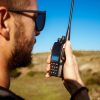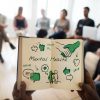Anesthesiologists are vital to the surgical process because they help guarantee the patients’ safety and well-being prior to, during, and following surgery. The importance of anesthesiologists’ work justifies their high pay. US Indeed, according to the U.S. Bureau of Labor Statistics, it is among the top 20 highest-paying jobs in the nation.
To become a certified professional in anesthesia, you will need to put in years of hard work and dedication. If you want to learn how to become an anesthesiologist, here is what to expect.
What Does an Anesthesiologist Do?

The anesthesiologist meets with the patient and surgeon prior to a scheduled medical procedure to review the patient’s condition. The anesthesiologist works with the patient to reduce pain and maintain comfort after the procedure and keeps an eye on the patient’s vitals throughout to ensure the patient is safe while sedated.
Additionally, anesthesiologists can help patients manage their chronic pain or chronic back pain or heal from injuries by offering pain management services. If you are looking for the steps on how to become an Anesthesiologist, keep reading.
How to Become an Anesthesiologist?

Before you ask how to become an anesthesiologist, you must understand that it is a demanding profession that calls for extensive schooling and training. It can take 12 to 15 years after high school to become fully certified and licensed to practice, so it’s not for everyone.
These are the steps you must follow if you determine that becoming an anesthesiologist is the right career path for you. Here is all that you need to know on how to become an Anesthesiologist.
Bachelor’s Degree
You must first complete your undergraduate degree. You are not required to major in anything, but it could be beneficial to take science and math-related courses. Nonetheless, research indicates that premedical students majoring in the social sciences or humanities have superior communication skills when interacting with patients.
Although specific majors may not be required by medical schools, the Medical College Admission Test (MCAT) will assess your knowledge of scientific concepts, so gaining admission to medical school will require a strong foundation. Think about enrolling in science or biology courses as electives if your major is in something non-scientific.
Medical College Admission Test (MCAT)
The MCAT is a four-part test designed to assess your critical thinking and problem-solving abilities and your comprehension of scientific ideas and concepts. You will receive five scores on the MCAT: one total score and scores for each of the four sections.
You can use an online study tool from the Association of American Medical Colleges to get ready for the MCAT. The National Association of Advisors for the Health Professions has a network of volunteer advisers. They can assist you in choosing the appropriate courses to get you ready for the test.
Medical School
It’s possible to apply to medical schools after passing the MCAT. The application procedure may take a long time. The American Medical College Application Service (AMCAS), a centralized application for medical school, must be filled out. The nine sections of the AMCAS address your educational history, personal essays, letters of evaluation, as well as coursework.
Every medical school you apply to might require you to complete a secondary application. The majority of them will demand an in-person interview. Prospects for medical school will also have their backgrounds checked. You will complete four additional years of education if you are admitted as a medical student.
Residency
After graduating from medical school and receiving your Doctor of Medicine (MD) or Doctor of Osteopathy (DO) degree, you will need to finish a four-year residency program in anesthesiology. In hospitals or clinics that specialize in their chosen field, residents will receive training.
It can be a taxing experience to be in residency. All clinical and educational activities are included in the 80-hour workweek that residents are allotted, and they may be required to work 24 hours in a row.
Fellowship
Some anesthesiologists can complete a fellowship in lieu of their residency training. They receive specialized training in fields such as obstetric anesthesia, pediatric anesthesia, and pain management during their fellowship. Typically, fellowships are awarded for one or two years.
Licensure and Certification
To practice medicine, you need to obtain a state license after finishing your residency and any optional fellowship. The state’s medical board will review your training and educational background when you apply for a medical license. You will need to provide documentation that you passed all three sections of the US Medical Licensing Examination.
The time between applying for a license and when it is granted can be up to sixty days. To become board-certified, you can also sit for the American Board of Anesthesiology exam. Although certification is not necessary, it is a helpful way to demonstrate your expertise to employers and patients. Of anesthesiologists, about 75% hold a board certification.
Training Of an Anesthesiologist

If you are thinking about how to become an anesthesiologist, you must start with a bachelor’s degree. Your undergraduate studies should equip you with a broad foundation of knowledge in the sciences and liberal arts since medical school is your goal. You should also take the Medical College Admission Test (MCAT) prior to graduating.
Having a strong MCAT score and volunteering or doing internships in the medical field will help you get into the medical school of your choice.
The average length of medical school is four years. The last two years are devoted to learning clinical practice under the guidance of medical professionals in a range of healthcare settings, while the first two years are primarily devoted to classroom and laboratory instruction.
Prospective anesthesiologists must finish a four-year anesthesiology residency after graduating from medical school. The National Residency Matching Program (NRMP) is a nationwide system that matches medical school graduates with residencies.
To learn how to practice their chosen specialty, residents receive instruction from highly qualified medical school faculty. A fellowship is a further training program that some physicians pursue after completing their residency to specialize in anesthesiology. It covers topics such as pain management, pediatric anesthesiology, or obstetric anesthesiology.
Certification Requirements
An anesthesiologist can become certified by the American Board of Anesthesiology and receive a license to practice medicine in their state upon completing a residency program. While not all anesthesiologists are board-certified, practicing medicine requires a state license.
The requirements for becoming a physician vary by state. But most of them include graduating from medical or osteopathic school. You will also need to complete a residency program for at least a year and pass licensing exams. States usually use the National Board of Osteopathic Medical Examiners (NBOME) examinations and the multi-step United States Medical Licensing Examination (USMLE) to license physicians.
Anesthesiologists must pass three tests to become certified by the ABA:
- Following the second year of residency, candidates take the BASIC exam, which covers the scientific underpinnings of anesthesiology practice.
- After completing the residency, candidates take the ADVANCED exam, which covers advanced and clinical aspects of anesthesiology practice.
- Candidates who pass the ADVANCED exam are eligible to take the APPLIED exam, which consists of oral and clinical exams. After finishing their residency, anesthesiologists have seven years to pass this test.
Who Is an Anesthesiologist Assistant?

Are you wondering how to become an anesthesiologist assistant? The four-year undergraduate degree program for anesthesiologist assistants includes fulfilling pre-med requirements. Highly qualified medical professionals who have successfully finished an approved anesthesiologist assistant education program are known as anesthesiologist assistants.
A student can obtain certification by passing the National Commission for Certification of Anesthesiologist Assistants exam (NCCAA) after completing an approved AA program. The National Board of Medical Examiners (NBME) provides performance information for the test items and the overall examination.
AAs receive extensive training in both cutting-edge patient monitoring techniques and the provision of safe, high-quality anesthesia care. Licensed physician anesthesiologists oversee the work of AAs, who are nonphysician anesthetists, in carrying out anesthesia care plans. An AA is not allowed to practice without an anesthesiologist’s supervision or outside the field of anesthesia.
Who is a Nurse Anesthetist?

A registered nurse who has successfully finished an approved program in nurse anesthesia is a nurse anesthetist. All applicants to nurse anesthetist programs must hold at least a Bachelor of Science degree (though not necessarily a Bachelor of Science in nursing). This is in accordance with a 1980 American Association of Nurse Anesthetists mandate that went into effect in July 1987.
To enroll in an approved nurse anesthesia training program, nurses must have completed at least one year of practical experience. After completing a two- to three-year program, they must pass an exam to become nationally certified.
Nurse anesthetists are non-physician anesthetists who work in a variety of surgical settings, administering anesthesia with a focus on patient care. Although they might also be supervised by other medical professionals, they are usually overseen by a physician anesthesiologist.
What is an Anesthesia Care Team?
A physician anesthesiologist leads the Anesthesia Care Team. It is made up of resident physicians trained in anesthesia care and physician anesthesiologists supervising qualified nonphysician anesthesiologists. Physician anesthesiologists may assign suitable tasks and patient monitoring to nonphysician anesthesia providers in an Anesthesia Care Team. But they will still be ultimately responsible for the patient.
The Anesthesia Care Team collaborates to give every patient the best possible anesthesia experience. Both doctors and non-doctors are essential members of the anesthesia care team. This includes anesthesiologist, anesthesiology fellow, anesthesiology resident, anesthesiologist assistant, nurse anesthetist, anesthesiologist assistant student, and student nurse anesthetist. Significant contributions are also made by other medical specialists to the patient’s peri-anesthetic care.
The physician anesthesiologist overseeing the Anesthesia Care Team manages the team members, prescribing the anesthetic plan, managing the anesthesia care, and anesthesia consultation to maximize patient safety.
What to Keep in Mind When Evaluating an Anesthesiology Program?
Prospective anesthesiologists should only consider accredited programs when choosing between an MD and a DO. It is unaccredited to enroll in an unaccredited program to become licensed.
Anesthesiology is a specialty that both MDs and DOs can pursue. Therefore, prospective students should think about whether they would rather study traditional Western medicine in an MD program or whole-person patient care and preventive medicine, as in a DO program.
A prospective medical student should consider the advantages of online programs. Moreover, they must also consider the reputation, location, and cost of various medical schools.
Who Is Best Suited for Being an Anesthesiologist?
When assessing, diagnosing, and treating a patient, anesthesiologists must be quick on their feet and have a solid background in medical science. Moreover, they must exude confidence. Learning and planning how to become an anesthesiologist means you will need a personality to support the strenuous line of work you have chosen.
Often, anesthesiologists have far less time to make a diagnosis, choose a course of treatment, as well as give out prescriptions. When placing orders and making decisions, they must rely on themselves and have the confidence to act quickly.
Anesthesiologists should also have good hand dexterity and agility. They use ultrasounds for nerve blocks and regional anesthesia, as well as endotracheal intubation to insert IVs, arterial cannulas, and breathing tubes daily.
Anesthesiologists must be proficient in these procedures and able to rely on their own skill set to perform them accurately and quickly.
Lastly, anesthesiologists must be charismatic and can build rapport with patients fast. The uncertainties surrounding general anesthesia can be one of the most insecure experiences of a patient’s life for many. Anesthesiologists frequently have no more than ten minutes to speak with the patient, get the necessary information, and build confidence that everything will be handled correctly and that the patient will get to the recovery area safely.
What To Expect from a Course in Anesthesiology?

You must learn a lot of material quickly in medical school so you can apply it to clinical decision-making when you work with patients in a hospital. During this period, you are also concerned with ensuring that your performance, test results, and grades will be sufficient to be accepted into the specialty of your choice at an appropriate residency program.
Residency is just as demanding as medical school. When factoring in hours worked per month, you often get paid for working 60–80 hours per week at minimum wage or less. After completing this difficult process, you ought to be sufficiently prepared for something very significant: caring for people.
There is a rationale behind the extensive training required to reach this stage. In addition to passing the three-part USMLE Step exam, passing the basic and advanced anesthesia board exams is necessary to become a board-certified anesthesiologist. The resident physician now possesses all the necessary certifications as well as credentials to practice anesthesiology.
Want to know what a midwife does? Click here.
Other Careers in Anesthesiology

What is the duration of training to become an anesthesiologist? Having discovered the solution, you might be considering additional choices.
To answer the Google search question, “how many years to become an anesthesiologist?” It takes more than a decade. If 12 to 15 years of education and training are not enough time to achieve your goals, you might want to think about pursuing another line of work. There are alternative career paths in the field of anesthesiology that take far less time in school if it interests you:
Anesthesia Technician: Medical professionals are not nurses or doctors. Rather, they oversee and maintain the anesthesia apparatus and play a supporting role. You must pass the American Society of Anesthesia Technologists certification exam and finish a two-year associate degree program to become a certified anesthesia technician.
A Certified Anesthesiologist Assistant (CAA): They are medical professionals with a master’s degree. These specialists are limited to practicing in specific nation regions and are only permitted to administer anesthesia under an anesthesiologist’s supervision. Becoming a certified advisor (CAA) requires a bachelor’s master’s and certification. This means that becoming a CAA typically takes six years.
A Certified Registered Nurse Anesthetist (CRNA): A CRNA is a healthcare professional who provides anesthesia and patient care both during and following medical procedures. In seven to ten years, CRNAs can obtain their credentials and start working. Students must finish a bachelor’s degree and obtain a master’s degree in nurse anesthesia from an educational program to be eligible for a CRNA.
Wrapping Up
Having acquired knowledge about becoming an anesthesiologist, you can now strategize your professional journey. Get the best grades you can and lay a solid foundation for medical school if you’re a senior in high school or a college student.
You can get information on getting ready for medical school from the Association of American Medical Colleges resources. They include practice tests, advice on how to pay for medical school, and pointers on navigating the application process.
If you have thoughts to share or questions to ask about how to become an anesthesiologist, please leave a comment below. We would love to hear from you!
We also have more information if you want to know how to become a pediatrician, a therapist, an orthodontist, a phlebotomist, a psychologist, or a physician assistant.
Learn More About:






















